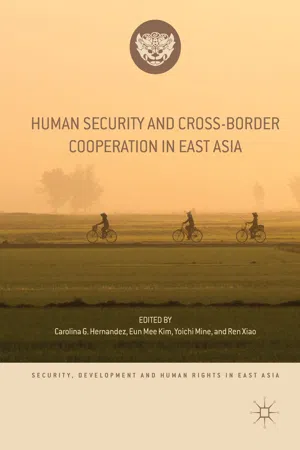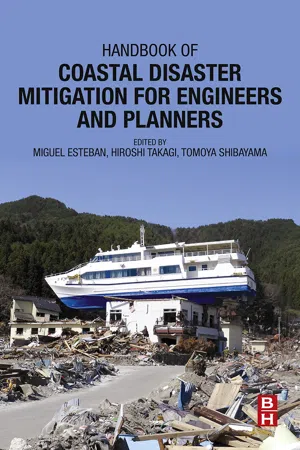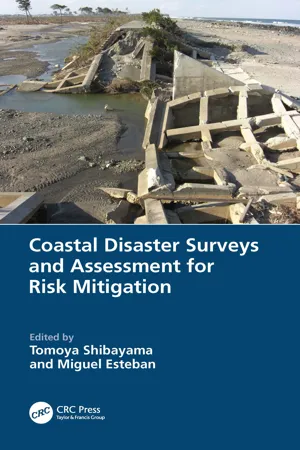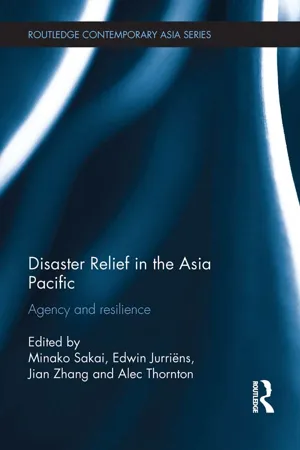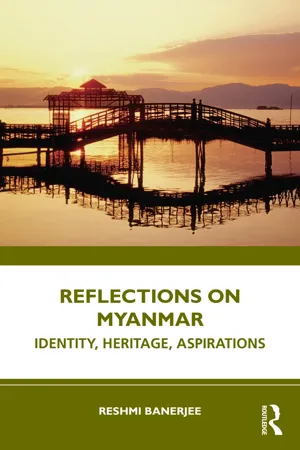Geography
Cyclone Nargis
Cyclone Nargis was a devastating tropical cyclone that hit Myanmar in May 2008. It was one of the deadliest cyclones in recorded history, with over 138,000 people reported dead or missing. The cyclone caused widespread damage to infrastructure and agriculture, and led to a humanitarian crisis in the affected areas.
Written by Perlego with AI-assistance
Related key terms
Related key terms
1 of 4
Related key terms
1 of 3
5 Key excerpts on "Cyclone Nargis"
- Carolina G. Hernandez, Eun Mee Kim, Yoichi Mine, Ren Xiao, Carolina G. Hernandez, Eun Mee Kim, Yoichi Mine, Ren Xiao(Authors)
- 2018(Publication Date)
- Palgrave Macmillan(Publisher)
© The Author(s) 2019Begin AbstractHuman Security and Cross-Border Cooperation in East Asia Security, Development and Human Rights in East Asia https://doi.org/10.1007/978-3-319-95240-6_6Carolina G. Hernandez ,Eun Mee Kim ,Yoichi Mine andRen Xiao (eds.)6. Cyclone Nargis in Myanmar: The Perfect Storm?
End AbstractBrendan Howe1(1) Graduate School of International Studies, Ewha Womans University, Seoul, Republic of KoreaIntroduction
Myanmar (also known as Burma) is a resource-rich emerging economy in Southeast Asia but remains one of the poorest countries in the region. Since independence from Britain in 1948, Myanmar has experienced a complex set of conflicts between successive governments and the people. The military seized power in a coup in 1962, and a series of military-dominated governments held sway until 2011. The country stands out as ‘a pre-eminent example of a post-colonial state subsumed in what development analysis describes as a conflict trap ’ (Smith 2007 , 3). Myanmar is also vulnerable to natural disasters , including cyclones , floods, storms, landslides, earthquakes, tsunamis , droughts and fires. Cyclone Nargis hit Myanmar on May 2, 2008. It was the deadliest natural disaster ever faced by the country and one of the most devastating storms recorded anywhere in the world.Nargis officially killed more than 140,000 people (UNEP 2009 , 3), although some put the toll at over 300,000 (Opposition #2 2016 ; Government #1 2016 ). The cyclone destroyed 707,500 tons of stored paddy and milled rice, 85% of all seed stocks were lost, 3,000 power tillers were lost, 37% of all orchard crops and 70% of backyard gardening were destroyed, and 28% of pigs, 52% of ducks, 30% of goats and 45% of chickens (UNFAO 2009 , 3–4). In the 11 most affected townships alone, 227,420 draught animals (50% of the buffalo and 25% of the cattle) were lost (UNFAO 2009 , 3–4). Nargis created further long-term humanitarian challenges. It had a devastating impact on the environment of the Irrawaddy and Yangon Divisions, where local livelihoods are heavily reliant on the natural resource base; 38,000 hectares of natural and replanted mangroves were destroyed, over 63% of the paddy fields were submerged, and 43% of all freshwater ponds were damaged (UNEP 2009 , 3). The cyclone caused widespread damage to agricultural infrastructure and buildings, and destroyed approximately 1,550 marine fishing vessels, up to 100,000 small inland fishing boats (50% of the fleet) and 70% of all fishing gear (UNFAO 2009 , 4). Approximately 800,000 people were displaced, of whom 260,000 sought shelter in camps and settlements throughout the delta (UNFAO 2009- Miguel Esteban, Hiroshi Takagi, Tomoya Shibayama(Authors)
- 2015(Publication Date)
- Butterworth-Heinemann(Publisher)
In comparison to neighboring countries like Bangladesh and India, cyclone induced damage had been comparatively lower in Myanmar before Nargis struck (Fritz et al., 2010). During the passage of Nargis most people in the Ayeyarwady Delta underestimated the damage that could result from storm surges and did not evacuate in time. Moreover, most people did not have any idea on how to prepare and where and when to evacuate due to a lack of any previous training on cyclone preparedness (PNPR I-IV (2008-2010)). By the time the affected communities realized the danger of the approaching cyclone it was too late. Another major cause for the heavy damage was the multitude of logistic problems which hampered relief supplies. Main roads and rivers were full of debris and therefore the delivery of relief materials was considerably delayed, which caused the death of many people in remote villages. Therefore, one of the main lessons learned from Cyclone Nargis was the need for better awareness on Disaster Risk Reduction (DRR) at the community level in Myanmar (Shikada et al., 2012) (Figure 20). Figure 20 Aerial photograph of the villages and newly constructed houses in the Ayeyarwady Delta, one year after Cyclone Nargis hit Myanmar. (Photo Credit: Ryo Matsumaru) After Nargis, different organizations took part in disaster management activities and noticeable progress was made on the relief to recovery process (Shikada et al., 2012) (Figure 21). The houses designed for those affected by the cyclone were upgraded in terms of the materials used in construction. In order to mitigate the risk from storm surge and other natural disasters, nine man-made hillocks were constructed in villages in the area. Mangrove plantation is being undertaken and wind breaking plantations are also being placed around some of the villages. The Swiss Development Cooperation-Humanitarian Aid (SDC-HA) constructed 42 schools that also act as cyclone shelters in rural areas of the Ayeyarwady Delta- Tomoya Shibayama, Miguel Esteban(Authors)
- 2022(Publication Date)
- CRC Press(Publisher)
Section 9.2 ). In contrast, the high death toll from Cyclone Nargis clearly highlights the danger that a severe tropical cyclone poses when it hits an area where people are less aware of the danger these weather systems represent (due to their relative smaller frequency). In addition, many residents did not evacuate during Nargis due to the misperception associated with past flooding experiences (as the areas are typically flooded several times a year due to heavy precipitation). Therefore, in addition to the rarity of the cyclone path and intensity, the lack of awareness and experience with such events likely contributed to the increase in human suffering due to this event.3.3.5 Conclusions
Cyclone Nargis in 2008 killed nearly 140,000 people, though given restrictions by the military regime in Myanmar at the time the true scale of the disaster was not well understood by the foreign community. In this chapter, an attempt was made to describe, albeit in a limited way, the storm surge generated by Cyclone Nargis, with reference to the results of some field surveys by international researchers. Storm surges of up to 5 m or more were observed over a wide area of the Irrawaddy Delta. Yangon, the capital of the country at the time, was also affected by the storm surge propagating through the Yangon River. Compared to its neighbour Bangladesh, Myanmar has historically been hit less frequently by cyclones, which may have contributed to a lack of awareness about such hazards. The case of Cyclone Nargis demonstrates that although the probability of a cyclone event taking place is low, when it does occur the consequences can be significant.3.4 Hurricane Sandy in 2012
Miguel Esteban Waseda University, Tokyo, Japan Takahito Mikami Tokyo City University, Tokyo, Japan Tomoya Shibayama Waseda University, Tokyo, Japan3.4.1 Introduction
On October 29, 2012, Hurricane Sandy made landfall along the eastern shorelines of the USA. The day before the storm arrived a mandatory evacuation order to the residents in Zone A (the area which was believed to be most likely to be flooded, including 375,000 residents), and a suspension of the rapid transit system (encompassing busses, subways, and trains) were carried out. The mayor and transportation authority repeatedly asked residents to recall the experience of Hurricane Irene in 2011 (New York City Government, 2014 ; MTA, 2014 ), as the same measures implemented during Sandy (a mandatory evacuation order and a suspension of the rapid transit system) were carried out during the passage of Irene (Mikami et al., 2015- eBook - ePub
Disaster Relief in the Asia Pacific
Agency and Resilience
- Minako Sakai, Edwin Jurriëns, Jian Zhang, Alec Thornton(Authors)
- 2014(Publication Date)
- Routledge(Publisher)
Asian Survey , 45 (3): 437–52.Seekins, D.M.(2009a) ‘State, society and natural disasters’, Asian Journal of Social Science , 37: 717–37.Seekins, D.M. (2009b) ‘State, society and natural disasters: Cyclone Nargis in Myanmar ( Burma)’, Asian Journal of Social Science , 37: 717–37.Selth, A.(2008) ‘Even paranoids have enemies: Cyclone Nargis and Myanmar’s fears of invasion’, Contemporary Southeast Asia , 30 (3): 379–402.Smith, M.T. (1994) Ethnic Groups in Burma: development, democracy and human rights . Online. Available at:www.ibiblio.org/obl/docs3/Ethnic_Groups_in_Burma-ocr.pdf (accessed 22 November 2005).Smith, M.T.(2005) ‘Ethnic politics and regional development in Myanmar: the need for new approaches’, in K.Y. Hlaing, R.H. Taylor and T.M.M. Than (eds) Myanmar: beyond politics to societal imperatives , Singapore: Institute of Southeast Asian Studies.Steinberg, D.I.(2005) ‘Myanmar: the roots of economic malaise’, in K.Y. Hlaing, R.H. Taylor and T.M.M. Than (eds) Myanmar: beyond politics to societal imperatives , Singapore: Institute of Southeast Asian Studies.Sunday Business Post(2008) ‘French naval aid ship Le Mistral due off Burma as junta refuses help’, Sunday Business Post , 18 May.Turnell, S.(2011) ‘Myanmar in 2010: doors open, doors close’, Asian Survey , 51 (1): 148–54.Union of Myanmar(2008) Constitution of the Republic of the Union of Myanmar , Nay-pyidaw: Union of Myanmar.United Nations (2013) United Nations Human Development Report . Online. Available at: http://hdr.undp.org/en/reports/ (accessed 23 April 2013).Vicary, A.(2010) ‘Ruling Myanmar: from Cyclone Nargis to national elections’, in N. Cheesman, M. Skidmore and T. Wilson (eds) Ruling Myanmar: from Cyclone Nargis to national elections - eBook - ePub
Reflections on Myanmar
Identity, Heritage, Aspirations
- Reshmi Banerjee(Author)
- 2023(Publication Date)
- Routledge India(Publisher)
Section 3 Re-evaluationPassage contains an image
11
Climate Change*A Permanent Reality for MyanmarDOI: 10.4324/9781003317180-15In May 2008, Cyclone Nargis struck Myanmar, causing loss of lives and widespread destruction of property. The category 4 cyclone strongly reiterated two facts: firstly, climate change and its repercussions have to be recognised and tackled; secondly, a natural disaster has the ability to bring people and civil society organisations together for re-building the spirit of the country. It was a critical moment of reflection for the nation, to take stock of its vulnerability and preparedness against an enemy which had generated havoc and panic for all.According to the 2016 Climate Risk Index, Myanmar was the second most vulnerable country in the world to the effects of climate change. The intensity and regularity with which cyclones make landfall have increased with every year, with the delta region affected by tropical storms and the dry zone impacted by debilitating droughts. Researchers at the Centre for Climate System Research at Columbia University, in collaboration with the Department of Hydrology and Meteorology, have stated that the country could see a rise in temperature1 by 1.3 and 2.7 degrees by the middle of the century along with an increase in precipitation by 2%–12% in 2011–40 and by 6%–27% in 2041–70. This is evident from the 2010 severe drought, a year which saw temperatures rise up to 47.2 degrees Celsius, a sure sign of global warming hitting the country hard. Dry seasons have become longer with shorter rainy seasons, thus inviting hardships for people in the form of water shortages and flooding.Both plant and animal life are bound to struggle due to the occurrence of anomalies in the natural environment. Shrinking of glaciers in the Himalayas can affect water supplies in rivers like the Irrawaddy and inundation of coastal areas with salt water can destroy agricultural production and trigger forced migration. According to data collected2 by the International Earth Science Information Network of Columbia University, over 5% of the country’s land area lies below five metres in elevation, home to 11% of the population, and is estimated to climb to nearly 14% by the end of the century. This could have grave consequences for an agrarian country like Myanmar, where agriculture is the main source of livelihood. A post-Nargis disaster case study revealed that decades of poor environmental policy had resulted in the reduction of mangroves by approximately 75% along the country’s coastline. This further exposed Myanmar to the ravages of climate change. Also, low.ly
Index pages curate the most relevant extracts from our library of academic textbooks. They’ve been created using an in-house natural language model (NLM), each adding context and meaning to key research topics.
Explore more topic indexes
Explore more topic indexes
1 of 6
Explore more topic indexes
1 of 4
